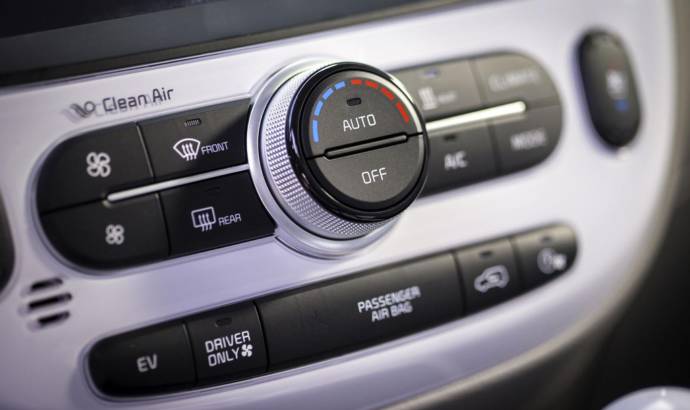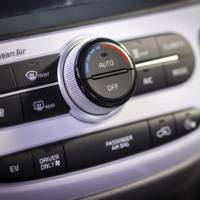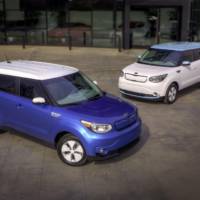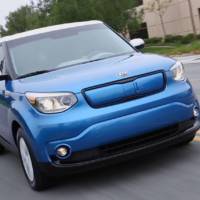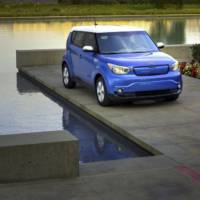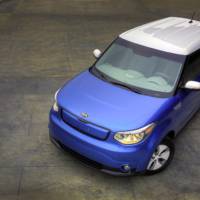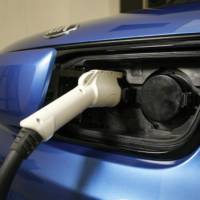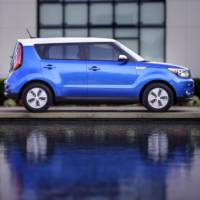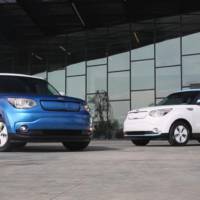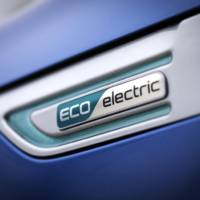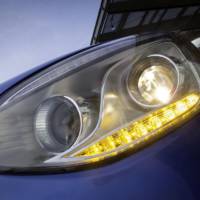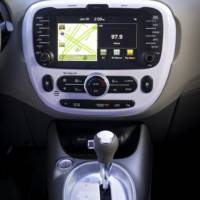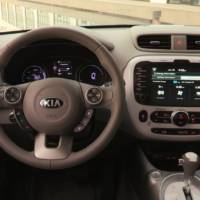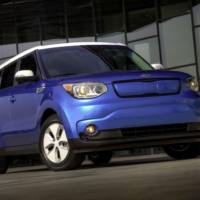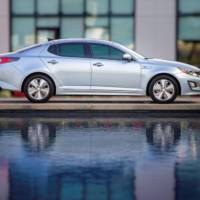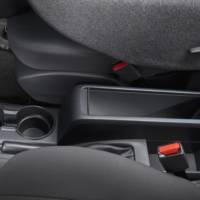Set to the sounds of soulful electrified blues music, Kia Motors America today hosted the global unveiling of the 2015 Soul EV at the Chicago Auto Show. Scheduled to go on sale in the third quarter of 2014, the Soul EV will be Kia’s first all-electric, zero-emissions car sold in the U.S. and expands the brand’s line of environmentally conscious vehicles. The Soul EV joined the refreshed 2014 Optima Hybrid on stage along with the Niro hybrid concept, illustrating Kia’s intent to lead the industry in providing technologically advanced vehicles that also reduce our dependency on non-renewable resources. Kia’s eco-friendly commitment was further underscored when Underwriters Laboratory honored the Soul EV with the organization’s first automotive environmental validation for its integration of more than 20 bio-friendly materials.
The Soul EV will initially be sold in California and Oregon in the West and several Eastern states including New York, New Jersey and Maryland, the regions with the largest EV markets and infrastructure. KMA will look to offer the vehicle in other markets in the near future as infrastructure and demand grow. Pricing for the Soul EV will be announced closer to the vehicle’s launch.
A top concern for EV buyers has commonly been range anxiety. The Soul EV addresses this issue by utilizing a highly energy-dense lithium-ion polymer battery. Located beneath the floor, the 27kWh, air-cooled, 200 watt-hour/kg battery is expected to yield a range of approximately 80-100 miles of real-world driving on a full charge, with internal testing and evaluation results exceeding 100 miles in some instances.
The 360 volt 96-cell lithium-ion polymer battery has been engineered for high capacity, thermal stability and safety. Accordingly, the battery features a nickel-cobalt-manganese cathode, which helps increase capacity, and a graphite-based anode, which increases durability while reducing weight. Additionally, the cells use a gel electrolyte, and each cell contains ceramic separators to significantly improve thermal stability and safety.
In an effort to maximize efficiency and range, the Soul EV uses Kia’s third-generation regenerative braking system to capture up to 12 percent of the car’s kinetic energy, which is fed back into the battery while the Soul EV is coasting and braking. Soul EV owners can choose between four different regeneration modes: “Drive” or “Brake” modes in Eco-mode “Off,” and “Drive” or “Brake” modes in Eco-mode “On” (the “Brake” setting with Eco-mode “On” producing the most regeneration).
The Soul EV makes charging easy by plugging into any standard 120v outlet or a conventional 240v EV charger. Two charging ports are standard, including a SAE J1772 port for Level 1 and Level 2 AC, and a CHAdeMo DC fast-charging port (480v). Found behind a sliding door located in the front grille, the dual ports offer flexibility and increase the Soul EV’s go-anywhere appeal, making it more convenient to charge inside the owner’s garage or when on the road. Recharging times vary from 24 hours for a fully depleted battery using a standard 120-volt outlet and under five hours when plugged into a 240-volt outlet. An 80-percent charge can be achieved in as little as 33 minutes with a 50 kW-output charger.
Kia has partnered with three charger providers – Bosch, Leviton and AeroVironment – which give Soul EV buyers an opportunity to select the unit best suited to their in-home needs. Additionally, Kia retailers who sell the Soul EV will offer charging at no cost to Soul EV owners, making charging even more convenient.
The front-wheel drive Soul EV is powered by an 81.4 kW, 109-hp electric motor, producing a generous 210 lb.-ft. of torque. The liquid-cooled AC synchronous permanent magnet motor uses multi-layer magnets to help improve efficiency and reduce the whine that’s commonly experienced with other electric vehicles. The motor delivers its power to the front wheels through a single-speed constant-ratio gear reduction unit. Acceleration from 0-60 mph is expected to take fewer than 12 seconds with a top speed electronically limited to approximately 90 mph. The battery’s location beneath the floor offers the stable feel of a lower center of gravity, which helps ride and handling and ensures that the EV remains true to the Soul’s fun-to-drive reputation. Additional cross bracing beneath the low-mounted battery contributes to a 5.9 percent improvement in torsional rigidity over the gasoline-powered Soul.
Improved aerodynamics and the absence of engine noise, combined with special sound-proofing materials, result in an exceptionally quiet ride. For the benefit of pedestrian safety, the Soul EV is equipped with a Virtual Engine Sound System (VESS) that emits an auditory alert at speeds below 12 mph and whenever the car is in reverse.
The Soul EV offers plenty of space inside the cabin thanks to minimal battery intrusion. Because of the battery’s flat design and location beneath the floor, there is only a slight 3.1-inch reduction to rear seat leg room (from 39.1 to 36 inches) from the non-EV Soul, yet Soul EV still offers more rear seat leg room than other key EV competitors. Rear shoulder and hip room remain unchanged from the gasoline-powered Soul, making Soul EV one of the roomiest in the segment. Rear cargo space is minimally impacted (reduced 5.1 cu.-ft. to 19.1) as the space under the cargo floor is utilized for the battery cooling fan and storage of the standard 120v portable charger.
The Soul EV also features Kia’s first use of Organic Light Emitting Diode (OLED) technology. Low energy consumption and virtually no heat build-up make OLED perfect for an electric-vehicle application. Found within the Soul EV’s exclusive Supervision instrument cluster, the 3.5-inch OLED screen is crystal clear and provides information on the vehicle’s energy flow, charging time, ECO driving level and energy economy, which measures how efficiently the battery is operating. Additionally, the OLED screen provides a three-stage alert for the Soul EV’s State of Charge (SOC), which allows the driver to quickly decipher how much charge remains within the battery and when it’s time to plug in to a charging unit.

